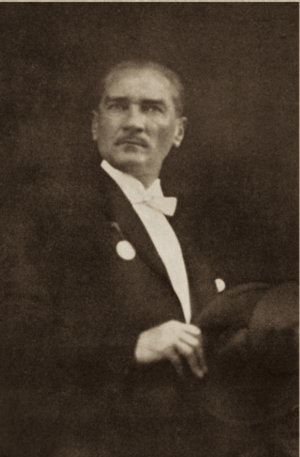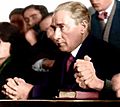Mustafa Kemal Atatürk facts for kids
Quick facts for kids
Gazi Mustafa Kemal Pasha (until 1934)
Kemal Atatürk (since 1934) |
|
|---|---|
 |
|
| 1st President of Turkey | |
| In office 29 October 1923 – 10 November 1938 |
|
| Prime Minister | İsmet İnönü Fethi Okyar Celâl Bayar |
| Preceded by | Office established |
| Succeeded by | İsmet İnönü |
| 1st Prime Minister of the Government of the Grand National Assembly | |
| In office 3 May 1920 – 24 January 1921 |
|
| Deputy | Fevzi Çakmak |
| Preceded by | Office established |
| Succeeded by | Fevzi Çakmak |
| 1st Speaker of the Grand National Assembly of Turkey | |
| In office 24 April 1920 – 29 October 1923 |
|
| Preceded by | Office established |
| Succeeded by | Fethi Okyar |
| 1st Leader of the Republican People's Party | |
| In office 9 September 1923 – 10 November 1938 |
|
| Preceded by | Office established |
| Succeeded by | İsmet İnönü |
| Personal details | |
| Born |
Ali Rıza oğlu Mustafa
(Mustafa son of Ali Rıza) 1881 Salonica, Ottoman Macedonia, Ottoman Empire (now Thessaloniki, Greece) |
| Died | 10 November 1938 (aged 57) Dolmabahçe Palace, Istanbul, Turkey |
| Resting place | Ethnography Museum, Ankara (21 November 1938 – 10 November 1953) Anıtkabir, Ankara (from 10 November 1953) |
| Nationality | Turkish |
| Political party | Republican People's Party |
| Other political affiliations |
Motherland and Liberty Committee of Union and Progress (He left it.) Association for the Defense of the Rights of Anatolia and Rumelia (Republican People's Party after 1923.) |
| Spouse | Latife Uşaklıgil (1923–25) |
| Parents | Ali Rıza Efendi Zübeyde Hanım |
| Relatives | Makbule Atadan (sister) |
| Awards | List (24 medals) |
| Signature | |
| Military service | |
| Allegiance | |
| Branch/service | |
| Rank | Major General (Ottoman Army) Marshal (Turkish Army) |
| Commands | 19th Division 16th Corps 2nd Army 7th Army Yildirim Army Group Army of the Grand National Assembly |
| Battles/wars |
List
Italo-Turkish War
Tobruk Derna Balkan Wars Bulair Adrianople II World War I Anzac Cove Baby 700 No.3 Post Nek Chunuk Bair Scimitar Hill Hill 60 Suvla Bay Sari Bair Bitlis Southern Palestine Transjordan III Nablus Megiddo Jisr ed Damieh Samakh Damascus Jisr Benat Yakub Kiswe Kaukab Pursuit to Haritan Khan Ayash Aleppo Charge at Haritan Greco-Turkish War Sakarya Great Offensive |
|
Graphical timeline
Detailed chronology
|
|
Kemal Atatürk (also known as Mustafa Kemal Atatürk) was a very important Turkish statesman and military leader. He was the first President of Turkey from 1923 until he passed away in 1938. He is famous for leading his people to freedom from other countries' control.
Atatürk also started many big changes that helped create the modern country of Turkey. He wanted Turkey to be a nation state that was more like Western countries, especially France. This included making the government separate from religion, a system called laïcité.
Contents
Who Was Mustafa Kemal Atatürk?
Mustafa Kemal Atatürk was born in 1881 in a city called Salonika. At that time, Salonika was part of the Ottoman Empire. Today, it is called Thessaloniki and is in Greece. His birth name was Mustafa. He later took the name Kemal when he was a schoolboy. When he became president, he was given the last name Atatürk, which means "Father-Turk."
His father was Ali Rıza Efendi, and his mother was Zübeyde Hanım. He also had a sister named Makbule. Mustafa Kemal became a talented army officer. He was the most successful general officer of the Ottoman Empire during World War I, especially known for fighting bravely in the Gallipoli battles.
How Did Turkey Become a Republic?
After World War I, the Ottoman Empire ended. Atatürk then organized a group of Turkish nationalists. They worked to create a new country, the Republic of Turkey. This new republic was different because its government was not led by kings or religious leaders. Instead, it was a secular country, meaning religion and government were separate.
If you visit Turkey today, you will see how important Atatürk is to the country. He was not only a great military leader but also helped create a democratic constitution. He made many changes that set Turkey on the path to becoming a new and developing nation. He inspired many other leaders around the world, like Habib Bourguiba and Gamal Abdel Nasser.
Atatürk's Six Guiding Principles
Atatürk's ideas are still important today. He created six main principles that helped guide the new Turkish government. These principles are like signposts for how a democratic country should be run:
- Republicanism: This means replacing a government led by a king or queen (a hereditary monarchy) with a government where people elect their leaders.
- Nationalism: This is about citizens working together with pride for their country and its common goals.
- Laicism: This principle means separating religion from the government. It ensures that everyone has the freedom to choose their own religion and beliefs.
- Populism: This idea states that all citizens are equal under the law, no matter who they are.
- Etatism: This is an economic system. It combines private businesses with large industries that are owned or supported by the government.
- Revolutionism: This is the most important principle. It means that society should always be ready to make new changes and improvements. These changes should be based on what society needs and what science and modern times suggest.
Images for kids
-
The reconstructed house of Atatürk's paternal grandparents, in the Ottoman village of Kocacık (Kodžadžik in present-day North Macedonia)
-
Atatürk (front row, second from left) with the Ottoman Turkish observers at the Picardie army manoeuvres in France, 28 September 1910
-
Atatürk (left) with an Ottoman military officer and Bedouin forces in Derna, Tripolitania Vilayet, 1912
-
Atatürk with Ottoman military officers during the Battle of Gallipoli, Çanakkale, 1915
-
Atatürk in 1918, the Commander of the Yıldırım Army Group and an Honorary aide-de-camp of the Sultan
-
Atatürk (right) in Angora (Ankara) with İsmet Pasha (left)
-
Prominent nationalists at the Sivas Congress, left to right: Muzaffer (Kılıç), Rauf (Orbay), Bekir Sami (Kunduh), Mustafa Kemal (Atatürk), Ruşen Eşref (Ünaydın), Cemil Cahit (Toydemir), Cevat Abbas (Gürer)
-
Atatürk at the opening ceremony of the Samsun-Çarşamba railroad (1928)
-
Atatürk in 1923, with members of the Mevlevi Order, before its institutional expression became illegal and their dervish lodge was changed into the Mevlana Museum. The Mevlevi Order managed to transform itself into a non-political organization which still exists.
-
In 1924, during his speech in Bursa
-
Atatürk is greeted by marines in Büyükada (14 July 1927)
-
Atatürk attending a class at the Law School of the Istanbul House of Multiple Sciences in 1930
-
Atatürk introducing the new Turkish alphabet to the people of Kayseri on 20 September 1928
-
In 1930, leaving the parliament after the 7th-year celebration meeting.
-
Atatürk with the Liberal Republican Party leader Fethi Okyar and his daughter in Yalova, on 13 August 1930
-
In 1931, during the establishment ceremony of the Turkish History Institution. Atatürk is standing with Afet İnan (on his left) and Yusuf Akçura (first from the left).
-
Atatürk with King Amānullāh Khān of Afghanistan in Ankara, 1928. King Amānullāh attempted to emulate many of Atatürk's reforms in Afghanistan, but was overthrown.
-
During a reception at the USSR Embassy in Ankara, on 7 November 1927
-
Exchanges on the concept of a Balkan Federation during the visit of Voroshilov, a vision of Atatürk's which was never achieved
-
During the visit of King Alexander I of Yugoslavia in 1931
-
Atatürk and Celâl Bayar visiting the Sümerbank Nazilli Cotton Factory, which was established as a part of the cotton-related industry
-
Atatürk supported large-scale government subsidized industrial complexes, such as Sümerbank, increasingly after the Great Depression.
-
Atatürk and İsmet İnönü at Nazilli Cotton Factory (1937)
-
Kemal Atatürk and his wife Latife Uşakizâde during a trip to Bursa, 1924
-
Anıtkabir, the mausoleum of Atatürk in Ankara, is visited by large crowds every year during national holidays such as Republic Day on October 29.
-
Associated Press news article about the admiration of women from different parts of the world for Mustafa Kemal Atatürk, the handsome leader of the Turkish Republic.
-
Atatürk memorial on Paseo de la Reforma in Mexico City
-
Statue of Atatürk in Ankara
See also
 In Spanish: Mustafa Kemal Atatürk para niños
In Spanish: Mustafa Kemal Atatürk para niños












































